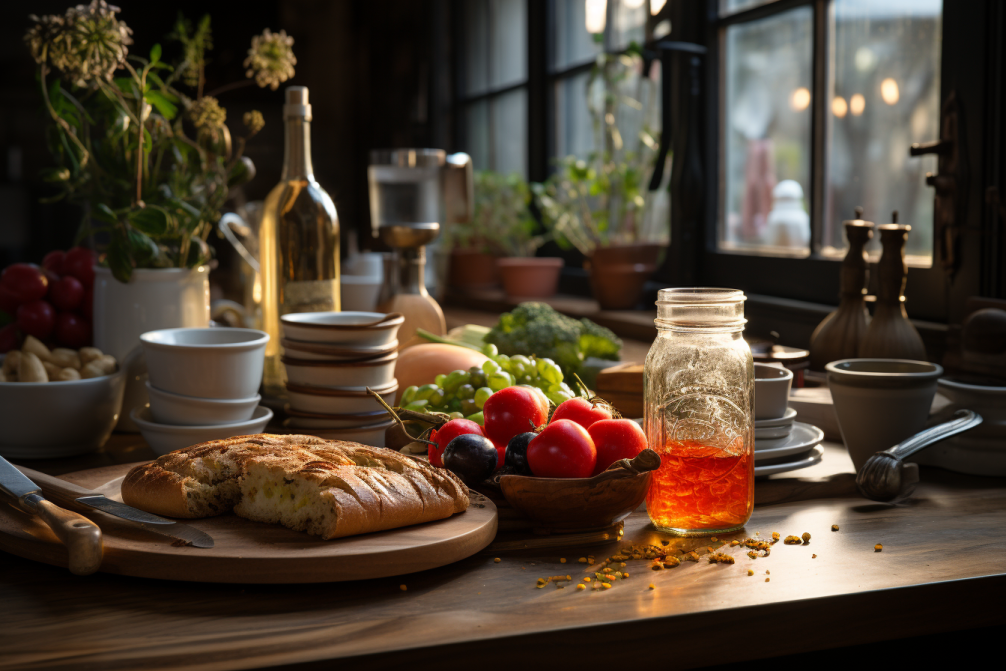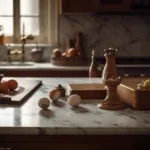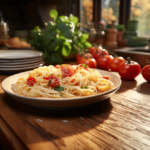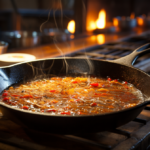Table of Contents
Mastering the Art of Luxury: Essential Tips for Preparing Fine Dining Dishes at Home
Hey there, food lovers! Ready to step up your cooking game and add some pizzazz to your dinner parties? Well, you’re in the right place. “Impress Your Guests: The Guide to Cooking Fine Dining Meals” is here to transform your kitchen escapades. We’re going beyond your usual ‘dump and pour’ recipes and venturing into a world where food is not just sustenance, but a work of art.
You might think fine dining is just for posh restaurants with fancy cutlery, but what if I told you that you too could whip up some gorgeous, mouth-watering dishes right in the comfort of your own kitchen? Yeah, you heard me right! Elevating your day-to-day meals is a lot easier than you imagine, and we promise it’s super rewarding.
Our guide is packed full of tips, tricks and tantalizing recipes guaranteed to drop jaws and captivate taste buds. From plush appetizers to decadent desserts, we’ve got all bases covered.
Whether you’re planning a romantic dinner date, or simply want to treat the fam to something a bit special, consider this your handy companion to creating delicious meals made to impress. Now, let’s get you ready to serve some serious culinary magic, shall we?
Building Your Foundation: Essential Kitchen Tools for Fine Dining
Hiya, home chefs! Want to take your cooking from drab to fab? Well, listen up, because we’re about to dish out some pointers on where it all starts – the kitchen essentials. Before the mise en place, before the flambe of a perfect crème brûlée, there’s one thing you need: the right tools. Here’s a rundown of the must-haves to pull off a fine dining meal at home.
- Quality Knives: You can’t exactly fillet a fish or julienne veggies without a good set of knives, right? These guys are your best friends in the kitchen. A chef’s knife, a paring knife, and a serrated bread knife should cover most of your bases.
- Cutting Boards: Don’t skimp on these. You’ll need one for veggies and another for meats to avoid cross contamination.
- Pots and Pans: Invest in a few high-quality pots and pans. A non-stick skillet, a stainless steel saucepan, and a good Dutch oven are all you need for starters.
- Measuring Tools: Precise measurements are key in fine dining preparation. Make sure you have a set of measuring cups and spoons, and a trusty kitchen scale.
- Mixing Bowls: Preferably in varying sizes so you can handle everything from mixing salad dressings to marinating that porterhouse steak.
- Trusty Utensils: Spatulas, spoons, tongs, whisk. You need these to stir, flip, and whisk to your heart’s content.
- Thermometer: Especially useful when dealing with meats to ensure they’re cooked to perfection.
- Baking equipment: If baking’s part of your menu, get a good set of baking sheets, muffin tins, or cake pans depending on your need.
- Fancy touches: Think creme brulee torch, pasta maker, etc. These aren’t required but will definitely add that magic touch to your meals.
Remember folks, these tools are an investment. Every masterpiece needs the right tools, and your kitchen is no different. With these bad boys, you’ll be whipping up meals that could rival any Michelin-starred restaurant in no time. So, what are you waiting for? Roll those sleeves up and let’s get cooking!
Getting Started: The Basics of Fine Dining Cuisine
Alright, foodies! So, you’ve got your snazzy kitchen tools at the ready, now what? It’s time to dive into the realm of fine dining cuisine. Let’s break it down to the basics because, just like any good meal, your culinary journey should start with a solid base.
Let’s take a glimpse into what makes fine dining, well, fine.
- Ingredients Matter: High-quality, fresh ingredients are a must. You won’t catch fine dining chefs using anything less than the best. See that local farmers market? It’s your new best friend.
- Presentation, Presentation, Presentation: Fine dining doesn’t just taste good, it looks amazing too. Go the extra mile to present your dishes, even down to the herbs sprinkled atop your masterpiece.
- Portion Size: Remember, in the world of fine dining, less is often more. Smaller, well-presented dishes are much more appealing than a huge mound of food, no matter how tasty it may be.
- Mouth-watering Recipes: From Scallops to Beef Wellington, find recipes that stir your soul and run with it. Remember, love for the dish often translates to the plate.
- Mind Your Techniques: Whether it’s sauteing, braising, or poaching, mastering a variety of cooking techniques will give you a wider range of dishes to impress your guests with.
- Flavour Harmony: Complementary and contrast flavors make dishes more exciting. A dash of citrus to cut through the richness of meat, a hint of sweet to balance the spicy—these are what create a harmonious flavor profile.
- Practice makes perfect!: Don’t let minor bumps discourage you. The path to culinary greatness takes time and patience.
So there you have it, folks! Your first step into the world of creating exquisite fine dining dishes. With these tidbits in your arsenal, you’re ready to tackle anything from succulent lobster bisque to a flawlessly cooked filet mignon. Be brave, be adventurous, and most importantly, have fun with it! Let’s unleash that inner MasterChef, shall we?
Perfecting the Art of Appetizers: First Impressions Count
Hey, culinary champs! It’s appetizer time. Remember, in the world of fine dining, we don’t just dive into the main, we ease into it. If the main course is the show, then the appetizer is the enticing trailer – a glimpse of what’s to come. It’s our job to make sure that this glimpse is irresistibly delicious. So, let’s understand the art of creating fine dining appetizers that never fail to impress.
- Go Fresh: Nothing screams luxury like fresh ingredients. So, hit your local farmer’s market and grab the best produce for your appetizer masterpiece.
- Size Matters: Keep your appetizers bite-sized and easy-to-eat. They should stimulate the appetite, not fill up your guests before the main event.
- Wow Factor: Remember, we eat with our eyes first! Your appetizers should look just as appealing as they taste. Detailing, garnishing, and presentation can turn a simple dish into a wow dish.
- Sweet, Sour, Bitter and Spicy Balance: Let your appetizers tingle all the taste buds. A good balance of flavors can get your guests excited for the meal ahead.
- Textures Time: A mix of textures can take your appetizers from ordinary to amazing. Something crunchy with something creamy? Yes, please!
- Temperature Play: Want to impress your guests even more? Play with temperature. A warm brie with a cool berry compote, or a cold gazpacho soup with hot, toasted croutons can be a delightful surprise.
- Practice Runs: Get a few practice runs in before your big day. Test your recipes, adjust the seasoning, and perfect the presentation.
So, folks, it’s time to roll up those sleeves and start “appetizing”. Whether you fancy a classic bruschetta, elegant oyster shooters, or a playful caprese skewer, these tips should help you get started on a delicious note. Remember, it’s all about making a stunning first impression and with your newly acquired skills, you’re sure to impress the socks off your guests. So, let’s get cooking!
Main Course Mastery: Cooking Techniques for Stunning Entrées
Welcome back, home chefs! Now that we’ve got our appetizers down, let’s move on to the star of the show – the main course or as the French say, the pièce de résistance. Take a deep breath, because we’re diving straight into some fine dining techniques that’ll make your entrées standout.
- Choose Your Hero: Whether it’s a decadent cut of steak, a tender fish fillet, or a vibrant array of vegetables, choose a star ingredient and let it shine in your dish.
- Cooking Techniques Matter: Grilling, roasting, searing, poaching—each method lends a unique flavor and texture to your food. Experiment with different techniques to find the one that suits your star ingredient the best.
- Sauce it Up: A well-made sauce can elevate your dish from good to sublime. Be it a rich beurre blanc, zesty gremolata, or classic red wine reduction, get creative!
- Sides Are Not Afterthoughts: Choose sides that complement your main. They should add flavor, texture, and color, enhancing the overall appeal of your dish.
- Show Off Your Skills: If you’ve honed a particular culinary skill, now’s the time to flaunt it. Handmade ravioli, expertly filleted fish, or perfectly fluffed soufflé anyone?
- Presentation is Key: Play with colours, shapes, and arrangement on the plate. Remember, your guests will eat with their eyes before their forks even touch the food.
- Temperature Tip: Serve hot food hot, and cold food cold. Nothing ruins a dish faster than incorrect serving temperatures.
And there you have it, folks! With these tips on board, you’re well on your way to serving memorable, drool-worthy entrées that are sure to impress your guests.
Be adventurous, take risks and remember, the main ingredient in any dish is love. So, put on that apron and whip up some fine dining magic in your own kitchen. Happy cooking!
Side Excellence: The Art of Complementing Your Main Course
Howdy, kitchen wizards! Today, we’re stepping away from the limelight and looking at the backbone of any fantastic meal – the trusty side dish. Now, we all know that fine dining is about a complete experience, not just one element. Great sides can not only complement your main course but can elevate it. So let’s delve into the world of fine dining sides.
- Pick Complementary Flavors: The first rule of choosing sides is that they must harmonize with your main dish. If your main is bold and spicy, opt for sides that offer a soothing contrast and vice versa.
- Vary Your Textures: Just as with your main dish, sides should offer a variety of textures. Creamy mashed potatoes, crunchy green beans, fluffy couscous – the options are endless!
- Remember, Colors are Your Friends: Vibrant sides can make your meal visually stunning. Grilled asparagus, fresh salads, or colorful roasted veggies can add that ‘Insta-worthy’ pop to your plate.
- Don’t Forget the Grains: Heart-healthy grains like quinoa, farro, or barley can be an excellent side and offer a nice contrast to your proteins or veggies.
- Have Some Fun with Sauces and Dressings: A great sauce or dressing can take a simple side dish to the next level. Try a fresh chimichurri on your grilled veggies or a flavorful vinaigrette on your salad.
- Give It the Time It Deserves: The sides are parts of the meal – don’t just slap them on as afterthoughts. Consider them in your meal planning, shopping, and preparation.
- Practice, Practice, Practice: Preparing your sides ahead of time for a major event or dinner can alleviate a lot of day-of stress.
So there you have it. Sides are not just fillers, they’re essential components of the culinary symphony that is your fine dining meal. Choose them with care, prepare them with love, and watch as they transform your meal from delicious to unforgettable. Ready to shake things up? Grab your apron and let’s get to it!
Decadent Desserts: The Sweet Spot in Fine Dining
Hey sweet tooth enthusiasts! Now that we’ve dished on appetizers, mains, and sides, it’s time to finish strong with the cherry on top – the dessert. In fine dining, dessert is more than just a sweet ending; it’s a final impression, a culinary encore, and we are here to make it one worth remembering.
- Complexity is Key: Fine dining desserts often involve several components – a rich cake, a velvety sauce, a crunchy topping. Each element comes together to create a feast for the senses.
- Play on Classic Combinations: Chocolate and coffee, strawberries and cream, lemon and ginger – some flavours were just made to be together. Don’t shy away from these darlings of the dessert world.
- Textures Matter: A great dessert is a symphony of textures. Creamy with crunchy, crumbly with gooey – every bite should be a surprise.
- Presentation, Just Like Your Mains: Pile on those layers. Drizzle that sauce. Place that mint leaf cherry at the absolute perfect angle. Every detail counts when it comes to presenting your dessert.
- Portion Control: Rich and decadent desserts can be heavy, so keep portion sizes on the smaller side. Additionally, miniature desserts can look extra cute and fancy!
- Decide the Star: Choose the hero of your dessert and build the rest of your components around it.
- It’s All About Balance: Balance your flavors. Sweet, tart, bitter, and even salty can be friends on a dessert plate.
So there you go, future pastry chefs! These are your tips to create mouthwatering desserts that are sure to leave your diners with a sweet impression. Whether it’s a classic Crème brûlée, an indulgent Chocolate Lava Cake, or a refreshing Mango Sorbet, remember to follow your instincts (and these tips) to create desserts that shine. Ready to get sugared up? Let’s tie those apron knots and get baking!
Wine Pairing 101: Choosing the Right Bottle for Your Meal
What’s up, aspiring sommeliers! So, you’ve prepared a stunning meal and are now wondering what elixir to serve alongside? Well, fret not; we’re popping the cork on the art of pairing wine with your fine dining delights.
- Basic Rule of Thumb: As a general guideline, light dishes tend to pair well with light wines, and rich dishes with full-bodied wines. But remember, rules are made to be bent (or sometimes broken).
- Match or Contrast Flavours: Matching flavours often leads to a harmonious experience, but don’t be afraid to contrast. Spicy food with a sweet wine, anyone?
- Red, White, or Rosé? White wines often compliment lighter dishes like fish, chicken, and vegetables. Red wines stand up well to robust, meaty mains. And for those fun, fruity dishes? A glass of rosé might be just the ticket.
- Experiment with Origin: The wine’s origin can give you fascinating pairing options. French wine with French cuisine, Spanish wine with tapas – the possibilities are endless.
- Consider Wine’s Acidity: High acid wines can create a bright, palate-cleansing effect, making them great companions for fatty or sweet dishes.
- Don’t Forget About Bubbles: Champagne and Prosecco are not just for toasts. They are accompanied stunningly with salty, fried, or spicy food.
- Trust Your Gut: What do YOU like? A meal is more enjoyable when you fancy the accompanying wine.
Experiment, and have fun with your pairings. There’s a whole world of flavours out there waiting to be discovered. Wine pairing is as much an art as it is a science, and the more you play with it, the more skilled you’ll become.
So there you have it, folks! Your lowdown on choosing the right vino to complement your culinary masterpieces. Ready to stir, sip and savor? Pop that cork, pour that first glass and say cheers to a aesthetically pleasing and scrumptious fine-dining meal! Here’s to eating and drinking well, my friends!
Setting the Scene: Fine Dining Presentation and Decor Tips
Hey there, masters of ambiance! We’ve cooked up a storm and picked the perfect wine; now let’s talk about setting the mood. Because let’s face it, fine dining is not just about the food and wine; it’s about creating an experience. So, let’s deep dive into the art of fine dining presentation and decor.
- Less is More: When it comes to table settings, simplicity and elegance are key. Stick to neutral tablecloths, shiny cutlery, and clean, spotless glassware.
- Master The Art of Plating: Food presentation is vital in fine dining. Play with colors, shapes, and textures. Use sauces and garnishes strategically and remember, the dish should look as good as it tastes.
- Lighten Up: Lighting can dramatically affect the ambiance of your dining room. Soft, warm light can create a cosy, intimate setting for your meal.
- Flowers and Candles: They aren’t just clichés. A simple flower arrangement and a couple of tapered candles can instantly elevate your table setting.
- Music Matters: Choose some background music that suits the mood. Nothing too loud or intrusive; just something to add a nice tonal backdrop to your conversation.
- Coordinate Your Serveware: Serving dishes should enhance your food, not distract from it. Ensure that they are clean, crack-free, and in accordance with your meal’s aesthetic.
- Don’t Forget the Comfort: Last but definitely not least, ensure that your guests are comfortable. Plenty of elbow room, accessible napkins, and a relaxed environment will make your dinner all the more enjoyable.
So, whizz-kids, it’s time to put these tips into action and give your guests a dining experience they’ll never forget. Remember, the magic of fine dining lies in the tiniest of details. The taste, the aroma, the ambiance, everything comes together in harmony to make your dinner just perfect. So, let’s get that table set, shall we?
Conclusion
Well, folks, we’ve covered a lot of territory here! From mastering your kitchen tools to acing the art of pairing wines, our journey through the land of fine dining has been nothing short of delicious. By now, I’m sure your taste buds are tingling with excitement and your mind is brimming with culinary ideas, waiting to be tested in your kitchen.
Remember, fine dining is not just about fancy dishes or intricate plating; it’s about creating a memorable experience. With every slice, stir, and simmer, you’re crafting a symphony of flavors meant to enchant your guests. So, don’t be afraid to get creative or to make a few mistakes along the way. After all, even the finest chefs started from scratch!
Use this guide as your secret weapon, your culinary compass guiding you through the realm of gourmet cooking. It’s time to take your pots and pans and paint an epicurean masterpiece that would make even a seasoned Michelin-starred chef give you an approving nod.
So, ready to cook up a storm and impress your guests? Step into your kitchen with confidence, flair, and a dash of creativity. Happy cooking, dear readers, and here’s to unforgettable evenings filled with laughter, elegance, and plates licked clean!









